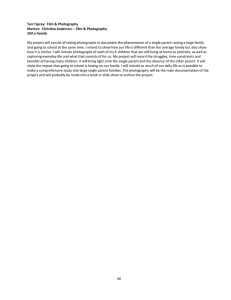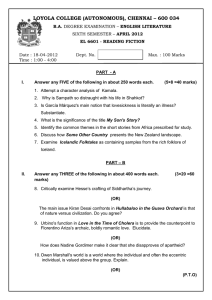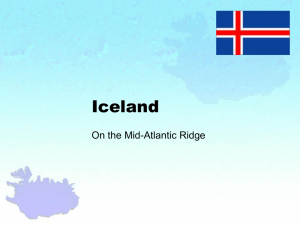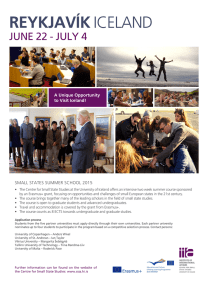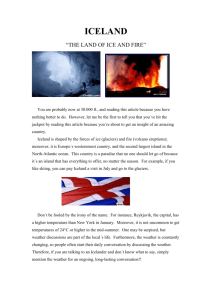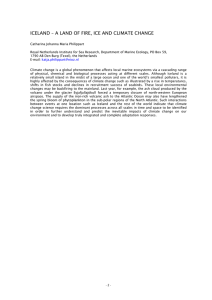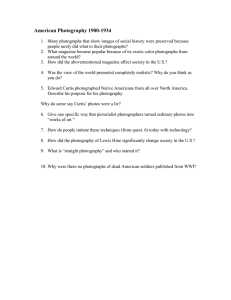Æsa Sigurjónsdóttir, French photography in 19th century Iceland
advertisement
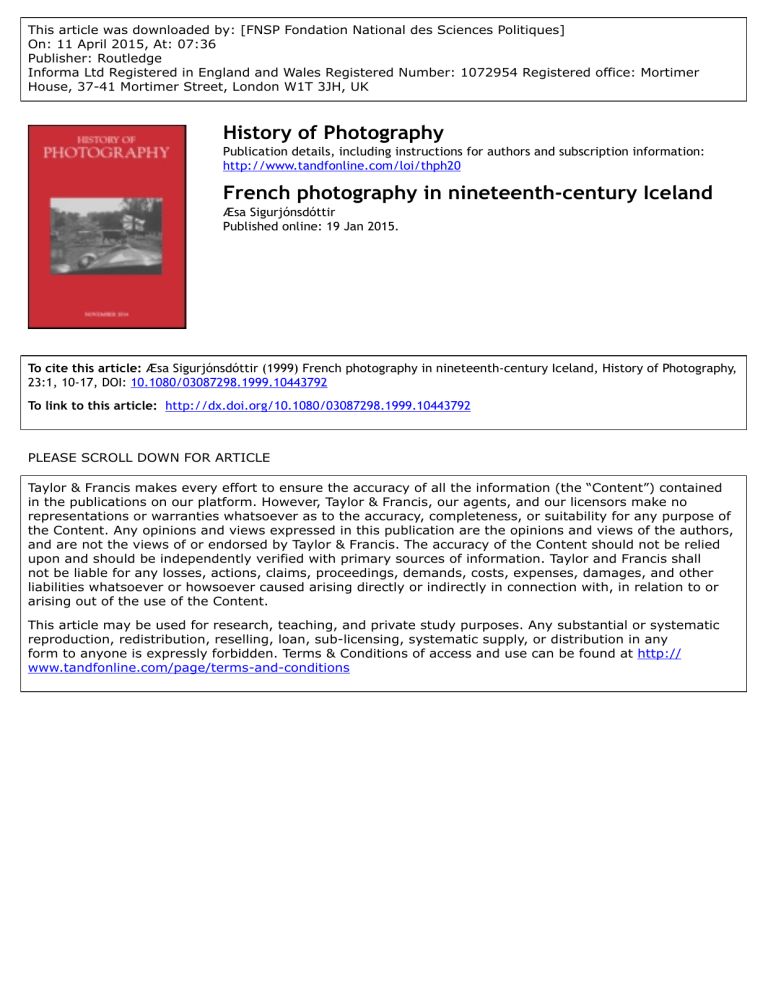
This article was downloaded by: [FNSP Fondation National des Sciences Politiques]
On: 11 April 2015, At: 07:36
Publisher: Routledge
Informa Ltd Registered in England and Wales Registered Number: 1072954 Registered office: Mortimer
House, 37-41 Mortimer Street, London W1T 3JH, UK
History of Photography
Publication details, including instructions for authors and subscription information:
http://www.tandfonline.com/loi/thph20
French photography in nineteenth-century Iceland
Æsa Sigurjónsdóttir
Published online: 19 Jan 2015.
To cite this article: Æsa Sigurjónsdóttir (1999) French photography in nineteenth-century Iceland, History of Photography,
23:1, 10-17, DOI: 10.1080/03087298.1999.10443792
To link to this article: http://dx.doi.org/10.1080/03087298.1999.10443792
PLEASE SCROLL DOWN FOR ARTICLE
Taylor & Francis makes every effort to ensure the accuracy of all the information (the “Content”) contained
in the publications on our platform. However, Taylor & Francis, our agents, and our licensors make no
representations or warranties whatsoever as to the accuracy, completeness, or suitability for any purpose of
the Content. Any opinions and views expressed in this publication are the opinions and views of the authors,
and are not the views of or endorsed by Taylor & Francis. The accuracy of the Content should not be relied
upon and should be independently verified with primary sources of information. Taylor and Francis shall
not be liable for any losses, actions, claims, proceedings, demands, costs, expenses, damages, and other
liabilities whatsoever or howsoever caused arising directly or indirectly in connection with, in relation to or
arising out of the use of the Content.
This article may be used for research, teaching, and private study purposes. Any substantial or systematic
reproduction, redistribution, reselling, loan, sub-licensing, systematic supply, or distribution in any
form to anyone is expressly forbidden. Terms & Conditions of access and use can be found at http://
www.tandfonline.com/page/terms-and-conditions
French Photography in Nineteenth-century Iceland
Downloaded by [FNSP Fondation National des Sciences Politiques] at 07:36 11 April 2015
.lEsa Sigurj6nsd6ttir
Alfred Descloiseaux
The French mineralogist Alfred Descloiseaux (1817-1897)
was probably the first person to take photographs in Iceland.
Later, he became professor at the Ecole Normale Superieure
and at the Natural History Museum in Paris, member of the
Academy of Sciences from 1869, and its president in 1889.
His speciality was the optical characteristics of crystals, and
how to use them for optical instruments. His studies are
now considered to be the solid foundation of modem
lithology. 1
What brought Descloiseaux to Iceland with his cumbersome Daguerrian camera in the summer of 1845? On the
initiative of his professor, the physician and mathematician
Jean-Baptiste Biot (1774-1862), he was sent on a government mission to Iceland to search for crystals, especially the
highly-prized Iceland spar, indispensable for optical instruments. It was only in Iceland that this form of crystal,
calcium carbonate rhomboid, could be found in a pure
form. 2 However, this was not the first time that the French
government had shown interest in exploiting the spar rnines
in the eastern part of Iceland. Descloiseaux was to continue
the research already begun by the naturalist Eugene Robert
during the Paul Gaimard mission in 1835-36, and was
requested to bring as many samples as possible back to
France. 3
At this time important activities and interconnections
between experiments in photography-science and the visual
arts took place at the French Academy of Sciences. Janet E.
Buerger has rightly pointed out in her book on French
Daguerreotypes how this interconnection between science and
arts created a particularly fertile situation in France for
research in the visual field: 'With the Academy fostering
scientific inquiry . . . France embarked on a century of
unparalleled discovery in the field of optics and the study of
light ... '. 4 Several expeditions were organized in this period,
in which daguerreotyping played an important part. 5
Descloiseaux left Cherbourg on 28 April 1845 on La
Prevoyante, which was in charge of surveying the activities
of French fishermen in Icelandic waters. He reached the east
coast of Iceland on 13 May and started to collect samples
from the Eskifjorour spar mines. According to his unpublished notes, he arrived at Reykjavik on 31 May, the time
10
0308-7298/99 © 1999 Taylor & Francis Ltd.
of year when the sun shines until midnight. He was not
feeling well and needed rest, so he spent the next three
weeks daguerreotyping in Reykjavik. Unfortunately only
two of his views of Reykjavik are preserved, two half-plates
conserved at the Conservatoire National des Arts et Metiers
(CNAM) in Paris: 'Tuesday 17th, June 1845. The weather
is quite fine, I start to daguerreotype, using exposures of
between 38 to 60 seconds depending on the state of the sky.
The portrait is more difficult, lack of a place well situated
in the shade of the sun.' From 18 until 21 June, he noted
only: 'I continue to daguerreotype'. Thursday, 26th: 'Rain
is pouring, at 4 o'clock I tried to daguerreotype and I
obtained to my astonishment in 1 112 minutes, a good
sample taken from one of the windows of the pharmacy
Moller, including the house of Halldora, the house of the
judge and the two houses of Mr. Knudson with a comer of
the College [this could be one of the daguerreotypes preserved at the CNAM] ... The square with the little round
stones and the tiny lanterns came out pretty well ... Friday,
27th June. I take two views, one of the harbour and another
of the town with the mill in 45 seconds. Very clear. I leave
one for Moller's father'. 6 The view of the harbour is probably
the one preserved at CNAM (figure 1).
In Reykjavik, good accommodation allowed him to
rest, write out his notes, and spend some time on daguerrian
activities. He photographed the main buildings of the small
town, counting about 1000 inhabitants at the time. He
participated in the main events of the summer: the visit of
a Dutch prince and the burial of the Icelandic Bishop
Steingrimur Jonsson. He established some social connections
and tried to photograph his new friends, a group of people
he refers to several times in his notes. They accompanied
him on short sightseeing tours and the young ladies instructed
him in the Icelandic language. 7 He spent the month of July
travelling around Iceland on La Prevoyante, first to the west
coast fiords Patreksfjorour, Dyrafjorour, bnundarfjorour,
visited by French fishermen since the eighteenth century.
He was particularly interested in the basaltic mountains
around and took several mineralogical samples. According to
his diary, he daguerreotyped the cliffs and the mountains
seen from the ship, mentioning some successful plates done
in 40 seconds. 8 The weather was unusually warm that
summer and his thermometer showed up to 36°C, which is
exceptional in those latitudes.
HISTORY Of PHOTOGRAPHY, VOLUME 23, NUMBER 1, SPRING 1999
French Photography in Nineteenth-century Iceland
Downloaded by [FNSP Fondation National des Sciences Politiques] at 07:36 11 April 2015
Image cannot be displayed for copyright reasons.
Please note source of the image in the caption below.
Figure 1. Alfred Descloiseaux, Anchorage in the bay of Reykjavik, daguerreotype, 1845. Conservatoire
National des Arts et Metiers, Paris.
When Descloiseaux returned to Iceland the following
year, he seems to have had much less spare time and he
referred only once to his daguerrian activities in his notes:
'Monday, 8th June. I have not yet daguerreotyped, either
our cottage of Helgustaoir [eastern Iceland], or the ravine of
spar, or the mountains, even though they are worth it. I
have to supervise my smelly Icelanders constandy, so I have
not time'.9 Moreover, Descloiseaux was so occupied with
scientific research that litde time could have been left for
photography. He climbed the volcano Hekla that had erupted
in September the previous year, did research on temperature
of the new lava field and took mineralogical tests, all in
collaboration with Robert Bunsen (1811-99), the enrinent
scientist from Marburg University in Germany. With him
he went to the Geyser area where they spent two weeks.
He also discovered in the western part of Iceland a new type
of crystal which he named Christianite, in honour of King
Christian VIII of Denmark, a monarch fascinated by archaeology and science as well as photography.lO
Back in France, there was much work to be done on
the important collection of nrinerals he had brought back
from Iceland. During the next two years he appeared several
times at the Academy of Sciences to present the results of
his research. liOn those occasions he may have brought his
daguerreotypes from Iceland and showed them to the members of the Academy, even though there is no reference
to this.
As a true daguerrian, Descloiseaux took most of his
photographs through a window and he managed to create
an almost urban view from the scattered houses of the small
town. While daguerreotyping he proceeded scientifically,
recording information about light conditions and exposure
times, which were relatively short (40-60 seconds). The
light is very bright in those latitudes, and even when it is
pouring with ram there is enough light to photograph.
Judging from the two half-plates that have been preserved,
as well as his written notes, his subjects were mosdy those
of the traveller: the ships' anchorage in the bay of Reykjavik;
the frontal view of the Knudsen houses; the College and the
house of the governor; the nrill. These subjects were already
known through lithographs in travel books, and those same
buildings, seen from more or less the same point of view,
continued to be photographed by later photographers. Even
though he was fascinated by the promising usefulness of
photography to the scientist, he did not succeed in using it
as a documentary tool for his nrineralogical research. He
talked about photographing the nrines in the east, but had
no time. Outdoor conditions were probably too bad to risk
the materials, and there was no place to prepare the plates. 12
Ten years later Descloiseaux would use daguerreotypes of
quartz crystals made by Jules Duboscq (1822-94) to illustrate
his theories on the structure of the crystal. This was reported
by all the photographic journals as the quintessential proof
of photography's usefulness to the scientist as a documentary
tool.!3 In March 1856, he presented a dissertation on
crystallization and the interior structure of quartz accompanied with engravings by Pierre Alphonse Salmon and Henri
Garnier made after photographic prints. 14 Descloiseaux
became a member of the French Society of Photography in
January 1856. 15
Louis Rousseau
In 1856, Louis Rousseau (1811-74) , assistant (aide-naturaliste)
and photographer in the zoological department of the Natural
History Museum in Paris, turned to the French Society of
Photography for information and instruction when preparing
his voyage to Iceland as photographer of the scientific
11
Downloaded by [FNSP Fondation National des Sciences Politiques] at 07:36 11 April 2015
EEsa Sigurjonsdottir
scientific interest to get some photographic views of different
expedition organized by Prince jerome Napoleon. 16 This
aspects of this ·phenomenon. Rousseau should discuss this with
was not his first scientific mission, but certainly his first as a
Mr Descloiseaux who has been in Iceland.
photographer. Rousseau had already participated in a mission
to Madagascar and the Seychelles in 1839, where he compiled Members of the Society also mentioned the interesting
an important collection of molluscs and reptiles for the studies of light that could be done in this northern area,
Museum.17 There he became aware of the problem of where the moon is extremely bright and it is possible to
graphic reproduction, while collecting and handling rare and catch the movements of the Northern Light~. Valenciennes
asked Rousseau to try to repeat his successful experiments
fragile specimens which were impossible to preserve.
Rousseau was a pioneer in biological and zoological at the museum of photographing under water, so that he
photography. He was born at the Museum, the son of a could bring back photographs of certain types of animals
modest employee, and was a self-taught naturalist. He became living under water, which were impossible to preserve. The
the assistant of Achille Valenciennes (1794-1865), a professor instructions were to be written out and handed over to
in zoology at the Museum and a member of the Academy Rousseau before his departure. The members of this commitof Sciences. With the help and advice of known photo- tee were Valenciennes, Bayard, Descloiseaux, and a certain
graphers at the time, such as Niepce de Saint-Victor Gueymard (possibly Paul Gaimard) who was also asked to
21
(1805-70) and Hippolyte Bayard (1801-87), he learned join them.
In 1855, the French government sent a request to the
photography, set up a studio at the Museum, and was
particularly concerned about searching for new solutions for Icelandic parliament to set up a fishing-station in Iceland. In
illustration. This research was executed on his own initiative january 1856 the Danish government received the same
and at his own expense. He is now best remembered for request from the French Government. The expedition dirheliographs executed with the painter and lithographer ected by Prince jerome Napoleon in the summer of 1856
Achille Deveria (1800-57), conceived as the beginning of a was felt by many Icelanders to be related to the French
larger proj ect, Photographie zoologique ou representation des government's desire to establish economic interests in
animaux rares des collections du Museum d'histoire naturelle. Even Iceland. The French had been fishing in Icelandic waters for
though the project was never accomplished and the methods at least 200 years, and when the Danish Trade Monopoly
they used were unsatisfactory, it showed how photography was abolished in 1855, the French sought permission to cure
could be useful to science, and it exposed the urgency of their catch on shore. Prince Jerome Napoleon was a nephew
resolving technical problems of reproduction and diffusion. of the Emperor and cousin of the Emperor Napoleon III,
Later, Rousseau collaborated with Louis-Alphonse Poitevin and the Dauphin until March 1856. His visit could not be
22
(1819-82) to create lithophotographic reproductions from construed as devoid of political and economic interests.
According
to
the
unpublished
travel
journal
probably
zoological photographs. IS
During the 1850s, Rousseau had been receiving encour- written by Charles Edmond, alias ChoYecki, 'capitaine d'etat
agement from Valenciennes for his experiments in wet- major de la garde nationale de la Seine' and author of the
collodion photography. On several occasions Valenciennes story of the journey, Voyage dans les Mers du Nord a bord de
presented Rousseau's photographs at the Academy, where la Corvette LA Reine Hortense, Rousseau photographed in
they were admired for their sharpness and precision. 19 His Iceland several times, but ran into difficulties with his
experiments were also reported by all the photographic press: equipment. Certainly, no photographs of geysers, northern
'We are astonished by their sharpness, the exactness of the lights or animals living underwater were taken: '1st july. At
detail, this is possibly the best application of photography ... five thirty, a grand dinner on board the Reine Hortense ...
Rousseau photographs the governor and the bishop'. Next
much more useful for teaching natural history than the best
day the prince leaves Reykjavik for a trip to pingvellir and
drawings. Rousseau's photographs give us Nature itself.
Geysir. 'We try to take a photographic view but we didn't
They are not the image of an object. It is the object itself
bring the "chambre obscure".' The Prince decided to send
we have in front of our eyes. Until now nobody has better
Rousseau and his assistant back to Reykjavik because the
exposed the usefulness of photography'. 20
photographic equipment was running into danger. Louis
At a session that took place on 16 May 1856 at the
Rousseau used the five days the prince spent sightseeing to
French Society of Photography, Valenciennes set up a
photograph in Reykjavik. Arriving at Geysir, the prince and
committee to define a programme for Rousseau to follow
his company were embarrassed to have made Rousseau go
on his journey to Iceland. Instructions were primarily of a
back to Reykjavik with his equipment, because they had
technical order: how to work in difficult weather conditions
run into the English Lord Dufferin (1825-1902) taking
(fog and low temperatures); and what subjects would be
photographs in the same area. 23
most interesting to photograph from a scientific point of
An exhibition was held in Paris in December 1856 at
view.
the Palais Royal showing not only photographs but also casts
It would be most interesting if Rousseau could bring us some and objects from the journey. This was reported by the
views of the geysers, not only general views but also details Parisian press at the time: 'The collection is arranged in the
of the silica incrustations and the deposits of quartz which
order of the journey. First we go through Scotland, Iceland,
they produce. The geysers have been admirably studied by
Bunsen who spent three summers close to them, but the Greenland, Faeroe Islands, Shetlands, Norway, Sweden
mineral formations he has perfecdy described cannot be and Denmark'.24 The Icelandic philologist Porleifur Repp
transported as they are too fragile. It would be of great gives this description of it in a letter of 1857: 'In three rooms
12
Downloaded by [FNSP Fondation National des Sciences Politiques] at 07:36 11 April 2015
French Photography in Nineteenth-century Iceland
in the Palais Royal, Prince Napoleon has put up an exhibition
with the priceless objects that he brought back from Iceland.
The exhibition is called 'Musee islandique' and only the
privileged are invited. Among the objects in the exhibition
are images of naked women. These are full length and show
the ladies honoured with the royal presence,.25 This could
be a reference to photographs but it is more likely that the
author of the letter is referring to casts executed during the
journey by Stahl, a specialist in the field from the Natural
History Museum. 26 In the Musee de l'Homme in Paris there
are still preserved moulds of several heads and body parts,
both male and female, executed in Iceland during the
journey.
In La Revue Photographique, 5 January 1857, there was a
report by Louis Figuier (1819-94), author of Les Applications
nouvelles de fa Saence
f'Industrie et aux Arts, under the
heading: 'Photographies du Voyage au nord de l'Europe de
son Altesse Imperiale Ie prince Napoleon': 'For the first time
photography has been used as an additional instrument for
the use of natural science in a voyage of exploration. The
results of this first attempt are such that they allow us to
affirm that in the future no scientific traveller can set off
without this new and powerful aid ... The example is
important ... 82 photographic views have been produced.'
He continued:
a
The photographs made by Louis Rousseau have been produced
in such unfavourable conditions of temperature and light that
they should be considered more like useful information than
finished images. They are sketches, but they are good enough
to show all the utility, all the advantages that photography
will soon obtain in better conditions. Rousseau has always
worked with the process of collodion. Sometimes prepared
beforehand, sometimes on the spot. Iceland was the first place
where this kind of photography was seriously tried out.
Rousseau took a view from the capital of Iceland, Reykjavik.
At the same time he photographed houses, ships at anchorage,
Icelandic fishermen and portraits of men and women of
different ages.
It was during the month of July that our travellers spent
their time in Iceland. At this time of the year there is no night
in those latitudes, so they tried to make photographs at alI
hours. Rousseau got one of his portraits of the Icelandic bishop
at eight o'clock in the evening on the deck of the 'Reine
Hortense'. Looking carefully at this photograph, one realises
the intensity of the light still at this late hour. He even made
experiments to photograph at eleven o'clock in the evening
when the sun went down. With success, as there was a plate
developed. 27
Of the 82 photographs brought back from the journey
and exhibited at the Palais Royal, few are preserved and
only one from Iceland: an almost full-length photograph of
an unknown young Icelandic woman at the Phototheque of
the Musee de l'Homme in Paris. A few photographs taken
in Greenland on the same trip are also to be found at the
Musee de l'Homme. Where the rest of the collection is
today remains a mystery. No 'scientific photographs' were
made and the gap between the scientific intentions
announced in the Bulletin de la Soaete franfaise de Photographie
and the final result is obvious. But some of the photographs
must have served as a model for the lithographs printed with
the story of the journey published in L'Illustration during the
summer of 1856, and the view of ReykjaVIK published in
Charles Edmond's book was definitely made after a photograph taken on the journey.28
Let us look at the unidentified young Icelandic woman
in traditional costume (figure 2).29 The original plate shows
her full length, but the print Rousseau made later for
exhibition showed her in an oval frame. She stares at us
with a hard, serious expression, looking fixedly into the
camera, without revealing any sign of her personality. She
has the passive and sad gaze so often seen in ethnic photography. Why was she chosen to be photographed? Could
she be one of the young women Stahl made a cast of, as
reported in the inventories of the Museum?30 Her hands,
visible on the original plate, are large and swollen and show
that she has worked since childhood. Her costume is of the
traditional, better type of wear of the 1850s with a full
woollen skirt, although the apron with flower motifs is
unusual. The jacket is tight, possibly knitted or cut from
woollen material edged with velvet, and she is wearing the
lady's traditional head-dress. The photograph has the
frontality of the anthropological image. It shows a type, not
an individual related to her social activities. The photograph
is very much in tune with the colonialist image most travel
writers gave of the Icelandic people: depressed, slow, and
smelling bad - living in a retarded static society. 'It is a
socially primitive state but not savage, similar to Europe
400-500 years ago,' observed the writer of the diary.31
Lively discussions about the usefulness of photography
to science were taking place in France in those years. The
Exposition Universelle that took place in Paris in 1855 put
an emphasis on the practical application of photography, and
the importance of distributing of images. There was also a
strong trend amongst critics such as Ernest Lacan (1828-79),
editor of La Lumiere, to get photography out of the private
sphere. Photography should assume a new social role of
functionality and utility.32 Both Lacan and Ernest Conduche
dedicated several articles to the topic, among them the
relation between photography and anthropology. 'What can
photography do for anthroplogy? Capture the imperceptible
fleeting elements of the human race. Turn anthropology
into a science ... In anthropology the photographer has to
look for and conserve the general type,.33
When Louis Rousseau took his photographs in
Reykjavik in 1856, anthropological photography had been
practised in France for over ten years. In 1840 Etienne Serre
(1786-1868), palaeontologist and professor of comparative
anatomy, bought a daguerrian camera for the Museum of
Natural History,34 with the intention of making documentary
photographs of bones, skulls and moulds. Photographs taken
by E. Thiesson in South America probably gave him the
idea of starting a collection of human portraits showing the
different races of the world. On 26 August 1844, Serre
showed at the Academy of Sciences daguerreotypes Thiesson
took ofBotocudes Indians. The following year, other images
by Thiesson taken in Portugal, showing various African
tribes, were shown at the Academy. On the same occasion
Serre presented a report discussing the importance of applying
photography to anthropology. These photographs seem to
have been the beginning of a series on the different races of
the world, intended to become raw data for scientists to
13
Downloaded by [FNSP Fondation National des Sciences Politiques] at 07:36 11 April 2015
.!Esa Sigurj6nsd6ttir
Figure 2. Louis Rousseau, Young Icelandic woman, 1856. Phototheque of the Musee de
I'Homme, Paris.
explore. 35 The project was continued by Henri Jacquart,
'aide-preparateur' at the laboratory of human anatomy, and
Philippe-Jacques Potteau, 'preparateur' at the laboratory of
zoology and collaborator of Louis Rousseau. 36
Surprisingly, a photograph of an Icelander, Bjarni Jonsson
(1809-68), belongs to this first daguerrian series of the human
races.37 He was a scholar, a specialist in grammar and philology,
who had spent several years in Copenhagen, where he earned
his university degree. Later, he became a headmaster. He spoke
fluent French and English and visited Paris three times. During
his first stay in Paris in spring 1845 he was photographed at
the laboratory of human anatomy, probably by HenriJacquart,
and possibly through the mediation of Paul Gaimard. Bjarni
Jonsson was probably photographed by Louis Rousseau in
Iceland during the summer of 1856, when Prince Jerome
Napoleon came to Iceland. He became his guide and personal
14
interpreter. Charles Edmond mentioned him several times in
his book as being educated and the perfect guide. 38 In 1860,
he was photographed by Louis Rousseau, in profile and full
face, according to the newly established anthropological standards of the museum. This time the photograph bears the
annotation 'very pure race' .39 The French naturalists were
terribly impressed by his physique. He was very tall, and
enormous both in size and character. Contemporary Icelandic
sources mention him as being an extremely big man with the
voice of a giant, and the writer of Prince Napoleon's diary
noted', 'it is true that he is enormous ... '. oj{) He seemed to
correspond to the French idea of the typical Nordic male. Not
only was he photographed at least twice, at a fifteen-year
interval, but his head was modelled and painted probably with
the idea of exhibiting it in the new spaces of the anthropological
department opened to the public in 1856. 41 However, these
Downloaded by [FNSP Fondation National des Sciences Politiques] at 07:36 11 April 2015
French Photography in Nineteenth-century Iceland
Figure 3. Anonymous photographer, Fish-drying at Pingeyri, 1858. The National Museum of Iceland, ReykjavIk.
two photographs, preserved at the Musee de l'Homme, were
taken in Paris in December 1860 whenJ6nsson came to Paris
for the last time. The pose and the fornJ.at are identical to the
anthropological photographs taken by Potteau during the early
1860s. Unfortunately Bjarni never mentioned being photographed, either in his letters written from Paris in spring 1845
or in his later correspondence. He only mentions having been
in touch with Paul Gaimard, but does not specifY why.42
In 1855, Armand de Quatrefage (1810-92), professor at
the laboratory of anthropology at the museum, the successor
of Etienne Serre, specified his instructions to travellers:
'Photographs should be taken in full size in profIle and full
face, in as great a number as possible,.43 These instructions are
repeated in a notice written by the laboratory of anthropology
in connection with the new edition of Instructions to travellers
published in 1860. 44 In 1868, the French Scientific Commision
recommended: 'It must be remembered that to be useful a
picture must always be taken very exacdy from the front or
very exacdy from the side. Any porttait from the 3/4 view
would be without any scientific value.' Later this method
would influence the photography specializing in identity
records for police files, as discussed and described in Identification
anthropometrique by Alphonse Bertillon, published in 1893.
The Artemise Photographer
A few years ago the National Museum of Iceland bought
from England nine photographs taken in Iceland during the
summer of 1858. The photographer is unknown, but he was
a member of the crew of Artemise, a French corvette, which
surveyed Icelandic waters between May and September
during the years 1856-61. Her role was to protect, survey
and assist French fishermen fishing in Icelandic waters. This
population represented around 3500 men. Most of the
fishing boats came from Brittany and they would spend up
to six months fishing. They would come ashore from time
to time, but contact between the French fishermen and the
Icelanders was limited. The officers, the captain and the
surgeons would exchange invitations with Danish and
Icelandic officials. 45
The Artemise photographs are the earliest photographs
preserved showing outdoor life in Iceland. However, the
subjects are familiar. One, which shows a view from
Reykjavik, reminds us of the print published in Charles
Edmond's book and probably made after a photograph taken
by Louis Rousseau. A print published in the Illustrated London
News on 26 June 1875 shows the same view. A similar
photograph must have been used as a model for that print. 46
Another view shows the harbour of Reykjavik. It is very
similar to the daguerreotype made by Descloiseaux in 1845,
preserved at CNAM. The other photographs are taken in
different locations in the western part of Iceland. Both
l>ingeyri and Dyrafjorour were fishing stations that the
French were farniliar with, and had been interested in for
curing their catch on shore, as mentioned before in relation
to Prince Napoleon's visit in 1856. Descloiseaux had also
15
Downloaded by [FNSP Fondation National des Sciences Politiques] at 07:36 11 April 2015
.lEsa SiguTj6nsd6ttir
visited this area and daguerreotyped the view to the mountains. The same coastline had been drawn meticulously in
1772 by the French artist Pierre Ozanne, a naval draughtsman
on the frigate La Flore. 47 All travellers since the sixteenth
century had been surprised by the importance of dried fish
in the Icelandic diet. It played the role of bread, was
extremely nutritious and could be conserved for a long time.
The wooden fish-drying shacks were already a favourite
subject among foreign draughtsmen (figure 3).
The captain of Artemise, Auguste Veron (1819-1901),
and its surgeon, Alphonse Aristide Jacolot (1831-?) were
both interested in Iceland and established relations with
Icelandic authorities and the population. Both wrote articles
relating their experiences. Jacolot went on his first mission
to Iceland in the summer of 1857. In an article published in
the Annales Maritimes in 1861,49 he discussed the sanitary
and nutritious conditions of the French fishermen and was
surprised by their good health, despite hard work in cold
weather. He was also interested in the health of the Icelandic
people and through an Icelandic surgeon, Jon Hjaltalin
(1807-82), he made contact with the population and was
able to study interesting medical cases. In remote areas he
would contact the priests, who usually spoke Latin, the
lingua franca, and they would bring sick people to him.
Jacolot had both studied the writings of Paul Gaimard,
Eugene Robert and Charles Edmond, whose books about
Iceland were in the ship's library, and also knew the medical
research carried out by his friend the college surgeon, J. H.
Guerault. 50 Whoever the photographer was, he was in
Iceland on a government mission, reporting on important
economic activities. He was carrying more than one camera
as may be seen in a photograph showing the church in
Grundarfjorour. The presence of a camera was to become
the rule on the military patrol ships, replacing the indispensable draughtsmen formerly employed by the French fleet.
Tn conclusion, all three French delegations to Iceland
were official and shared a similar motivation for travelling
to the country: the possible exploitation of its natural
resources, quartz mines and fish. Despite the scientific interest
of several subjects in Iceland, such as the geyser, Northern
Lights, and volcanoes, no photographs of these have survived.
According to written sources there was a great demand for
these subjects, but they were probably never realized, possibly
because of technical difficulties caused by bad weather and
the harsh conditions which made manipulations of photographic materials difficult. When the first landscape photographs were taken in Iceland there was already an established
itinerary of places and points of view, created and diffused
through prints in travel books,51 but the photographs are
first and foremost documentary. These rare photographs
taken by French travellers bring us nearer to social reality
than the abundant drawings and written accounts, which are
usually tinged with heroism and romanticism.
Notes
All translations are the author's.
1. Histoire des sdences, dirige par Rene Taton, Paris: PUEE 1996, 353-54.
2. A. Lacroix. Notice Historique sur A. Descloiseaux, Paris: Academie des
Sciences 1930.
16
3. Eugene Robert, naturalist at the Natural History Museum, collected
about 3000 volcanic and mineralogical samples during his stay in Iceland
during the summers of 1835 and 1836. He also brought to France an
almost complete Icelandic herbarium and several examples of birds and
animals. His collection was destined for the Natural History Museum.
Dossier personnel de E. Robert. Archives Nationales, Paris, AJ-15-551.
The mission was directed by a military surgeon, Paul Gaimard
(1793-1858), and was the most important organized to Iceland. Gaimard
had participated in the large expedition of Dumont d'Urville to Oceania
between 1826 and 1829; later, he wrote up the zoological part of that
journey, published between 1830 and 1835. He directed two expeditions to Iceland in 1835 and 1836, and was responsible for the
publication Voyage en Islande et au Groenland execute pendant les annees
1835 et 1836 sur 10 Corvette LA Recherche. Publie par ordre du Roi sous la
direction de M. Paul Gaimard President de 10 Commission sdentifique d'Islande
et de Groenland, 12 volumes, 1838-52.
4. Janet E. Buerger, French Daguerreotypes, Chicago 1989, 83, 84.
5. See Andre Ronille, LA Photographie en France 1816-1871. Textes &
Controverses: Une Anthologie, Paris 1989, 52-61.
6. A. Descloiseaux. Comets de voyage 1845 et 1846, preserved at the
Archives of the Academy of Sciences, Paris.
7. These were the Governor's wife Mrs Hoppe, ex-governor Bardenfleth,
and Ragnheiilur Guilmundsd6ttir, Astrfilur Thordersen, the daughter
of the new Bishop, Petur Sivertsen, and Halld6ra and Rannveig, Comets
de voyage.
8. Comets de voyage, 21 July 1845.
9. Comets de voyage, 1846.
10. Ida Haugsted, 'Un Danois fait ses premiers Daguerreotypes a Paris',
Paris et Ie Daguerreotype, catalogue, Musee Camevalet: Paris 1989.
11. Comptes rendus de I'Aeademie des Sdenees: 4. May 1846, 'Observations
£rites en Islande pendant l'ete de 1845'; 26. Oct. 1846, 'Note sur
l'hauteur de Hekla ct sur l'eruption qui a eu lieu en septembre 1845mars 1846'; 16. Nov. 1846, 'Note sur 105 temperatures des Geysers
d'isiande a difierentes profondeurs observees'; 15. mars 1847,
'Observations physiques sur les princip.ux Gey<ers d'Tslande'; 15. Nov.
1847, 'Sur la Christianite, nouvelle espece minerale'.
12. The mines were finally photographed in 1886 by another Frenchman,
Dr Henri Labonne (1855-1943?).
13. Janet E. Burger, 104-05. Comptes rendus 40 (1855), 1019-23, and LA
Lumiere 1855, 82.
14. Bulletin de 10 Sod8e Fran,aise de Photographie (BSFP), 1856, 74.
15. BSFP, 1856, 2.
16. For the only brief biography existing see Discours prononce auxfunerailles
de Louis Rousseau by Paul Gervais, Paris 1874. I would lik.e to thank
Mme Christine Barth at the Phototheque du Musee de I'Homme for
drawing my attention to this rare document.
17. Dossier personnel de Louis Rousseau, Archives Nationales, Paris,
A}-15-551.
18. For his work with Deveria, see Comptes, rendus, 1853, vol. 36, 991-93,
and with Poitevin, Comptes rendues, seance du 7. janvier 1856,
vol. 42,22.
19. Comptes rendus, 1853, vol. 36, 500, 626, 740; vol. 37, 409; vol. 39, 817;
1855, vol. 40, 1316; vol. 41, 151-52.
20. BSFP, 1855, 209-10; BFSP 1856, 157-59, and LA Lumiere 1855,
50-51. Revue Photographique, 1856. 114 and 179-80. See also Comptes
rendus 1855, vol. 40, 1316, vol. 41,151-52.
21. BSFP,jnin 1856, 157-59. Revue Photographique, October 1856,179-80.
22. Kjartan 6IaiSson, 1,,[orm Frakka urn nyIendu viii Dyrafjt\ril', Saga
(Reykjavik) 1986 147-203, and 'Dyrafjarilarm:iliil', Saga 1987, 89-166.
23. Journal du voyage, manuscript (Fond Napoleon 400 AP mic 164 2)
conserved at the Archives Nationales, Paris. The locations of the
photographs taken by Lord Dufferin in Iceland remain unknown.
24. L'fllustration, 20 December 1856, 386.
25. 6lalSson, Saga 1987, 107.
26. Charles Edmond (Cholecki), Voyage dans les Mers du Nord bord de 10
Corvette LA Reine Hortense, Paris 1857, 357-58.
27. Revue Photographique, 5 January 1857, 225-26.
28. Charles Edrnond (Cholecki), Voyage dans les Mers du Nord il bord de 10
Corvette LA Reine Hortense, Paris 1857,357-58.
29. Young Icelandic woman, by Louis Rousseau, 1856. Phototheque du
Musee de l'Homme, Paris, No. 4931.
30. Could she be Ragnheiilur 6lalSd6ttir, born 5 February 1838? Or,
Guilrun Bjamad6ttir born in Narfastallir, 1839, Sigrillur Bjarnad6ttir,
24 years old, born in Reykjavik, or Porei Amadottir, same age? All
these women had their limbs, torso and bust moulded by Stahl (still
conserved at the Musee de l'Homme, Paris).
31. Journal du voyage, manuscript (Fond Napoleon 400 AP mic 164 2),
Archives Nationales, Paris.
a
French Photography in Nineteenth-century Iceland
32. Andre Rouille, La Phowgraphie en France 1816-1871, 188-89.
33. See La Lumiere, 1855, 20; also 'La Photographie et I' Anthropologie' by
Ernest Conduche, La Lumiere 1855, 50-51.
34. E. T. Hamy, 'La Collection Anthropologique du Museum national
d'historie naturelle', L'Anthropologie 18 (1907), 267-68. La Sculpture
Ethnographique. De La Venus hottentote la Tehura de Gaugin. Les Dossiers
du Musee d'Orsay: Paris 1994, 15.
35. On the 26 August 1844, Serres showed at the Academy five daguerrian
portraits of Botocudes Indians taken by Thiesson, mentioning that a
collection of the various human races would be most useful for the
Museum of Natural History. Comptes rendus, VoL 19,490. and Comptes
rendus 1845, VoL 21, 242-46.
36. Traitements. Archives Nationales, Pari., AJ 15.200-211. At the French
Society of Photography in 1857, Rousseau showed again his photographs of skulls which were probably his best scientific photography:
'If the portraits of Eskimos are not as good, they deserve all our
attention considering the conditions they were made in. They form
certainly one of the most curious parts of the interesting task.' BSFP
1857,294.
37. Daguerreotype from 1845 showing Bjarni J6nsson. Phototheque du
Musee de I'Homme, D-80-1324.
38. Charles Edmond, 94-95.
39. Bjarni J6nsson. Two photographs by Louis Rousseau. Collection
Jacques Potteau. Phototheque du Musee de I'Honune, Paris. Nos. 4933
and 4934. Copies of the same photographs, mounted in an oval frame,
are preserved at the Bibliotheque National, collection Potteau.
40. See Bj5rn Th. Bj5rnsson, "Jeg hef ekkert sje6 eins feitt". Ma6ur a
tveimur myndum', Ur pl6gfari Gefjunar, Reykjavik 1996, 129-44.
41. Bust in plaster showing Bjarni J6nsson, moulded by Stahl, painted by
Froment, 1855, Laboratoire d'Anthropologie, Musee de I'Homme,
Paris. E. Conduche described those new exhibition spaces in 'La
Photographie au Museum d'Histoire Naturelle', La T.umiere, 18:;8, Ii 1.
Downloaded by [FNSP Fondation National des Sciences Politiques] at 07:36 11 April 2015
a
42. Letters from Bjarni J6nsson written from Paris in spring 1845 to his
friend Magnus Eiriksson, National Library of Iceland, Lbs. 305a foL
Letters from Bjarni J6nsson written from Paris (December 1860
and January 1861) to J6n Sigur6sson. National Archives, Reykjavik,
E.l0.2.
43. Ibid.
44. Instructions et reglements pour les voyageurs naturalistes, 17 December 1855,
Archives Nationales, Paris, AJ-15-565.
45. Documents on Artemise are to be found at Service historique de la
Marine Franl'aise, Vincennes archives, 7DDI-81, and Musee de la
Marine in Paris, file Artemise. Aha in Repertoire des navires de guerre by
Vichot, and Notice sur les batiments ayant porte Ie nom d' Artemise et
d'Artemis at Service historique de la Marine National, Cherbourg.
Unfortunately several documents, among those the crew lists from
1858, were destroyed by fire during the Second World War.
46. Sumarli6i isleifsson, islandframand; land, Reykjavik 1996, 189.
47. La Flore came to Iceland in the summer 1772. The expedition was on
its way back to France after a two-year cartographic exploration under
the direction of Verdun de la Crenne.
48. A. Rouilleault, 'Le Vice-Amiral Auguste veron', Sauvetage 43 (1992),
16-20. A. Veron, 'Grandes Peches', Annales Maritimes 2.sem. 1858,
315-25.
49. A. A. Jacolot, 'Relation medicale de la campagne de la corvette
I'Artemise en Islande', Annales maritimes, lersem. 1861, and 2. sem. 1861.
50. J. H. Guerault, Observations medicales recueillies pendant Ie voyage sdentifique
de S. A. R. Ie prince Napoleon dans les Mers du Nord, Paris 1857.
51. Sigulj6n Baldur Hafsteinsson, 'Rite of passage through the lens.
Photographs from Iceland in British travel accounts, 1875-1905', Gardar
27 (1997), 5-47.
17

